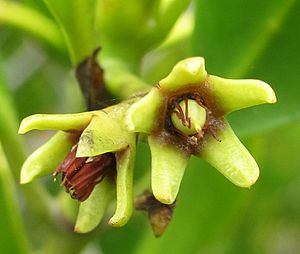Spurred mangrove facts for kids
The spurred mangrove (Ceriops tagal) is a special type of tree. It is also known as the Indian mangrove. This tree belongs to the Rhizophoraceae family, which includes many mangrove species. In South Africa, the spurred mangrove is a protected tree. Its scientific name, tagal, comes from the Tagalog language in the Philippines.
Quick facts for kids Spurred mangrove |
|
|---|---|
 |
|
| In Mozambique | |
| Conservation status | |
| Scientific classification |
Contents
What the Spurred Mangrove Looks Like
The spurred mangrove is a medium-sized tree. It can grow up to 25 meters (about 82 feet) tall. Its trunk can be as wide as 45 centimeters (about 18 inches).
Tree Shape and Roots
This tree often grows straight up like a column. Sometimes, it has many stems. It develops large, strong buttress roots that help support it. These roots spread out and can sometimes be seen above the ground. They might even loop up in places.
Bark and Leaves
The bark of the tree is usually silvery-grey to orange-brown. It feels smooth. You might see small bumps called lenticels on the bark. The leaves grow in pairs on opposite sides of the stem. They are shiny yellowish-green on top. Each leaf is oval-shaped with smooth edges. They can be up to 6 cm (2.4 in) long and 3 cm (1.2 in) wide.
Flowers and Fruit
The flowers grow one by one where the leaves meet the stem. Each flower has a long stalk. It also has a short cup-like part called a calyx. The flower parts usually come in groups of five or six. Inside the petals are two stamens (parts that make pollen). These petals open quickly if something touches them.
The fruit is oval-shaped and about 3 cm (1.2 in) long. It hangs from the small calyx. At first, the fruit is brown. As it ripens, its color changes. A long, slender part called a hypocotyl grows out of the fruit. This hypocotyl can grow to about 35 cm (14 in) long. It has ridges, which helps tell this mangrove apart from the smooth-fruited yellow mangrove (Ceriops australis).
Where Spurred Mangroves Live
The spurred mangrove grows naturally in many parts of the world. You can find it in eastern and southern Africa, and on the island of Madagascar. It also grows in the Seychelles, India, and the Maldives. Further east, it is found in China, Indo-China, Malesia, Papuasia, the Caroline Islands, New Caledonia, and Australia.
Habitat
These trees like to live in areas with brackish water. This means the water is a mix of fresh water and salty ocean water. They are often found close to the ocean's tidal lines.
How People Use Spurred Mangroves
The wood from the spurred mangrove is very strong and lasts a long time. Because of this, people use it to build houses.
Wood and Dyes
The wood is also used to make Charcoal. It is a popular choice for Firewood, second only to trees from the Rhizophora group. The bark of the spurred mangrove can be used to make a special dye. Among all mangrove species, its bark and sap give off red and black colors. These dyes are used in Batik (a way of dyeing fabric) and for tanning Leather.
Traditional Uses in the Philippines
In the Philippines, people use extracts from the dried bark. These extracts are called barok. They are used to make traditional palm wines called bahalina. The barok gives the wine a deep brown-orange color and a bitter, tangy taste. The bark is also used there to tan and dye leather.
Images for kids
See also
 In Spanish: Ceriops tagal para niños
In Spanish: Ceriops tagal para niños






